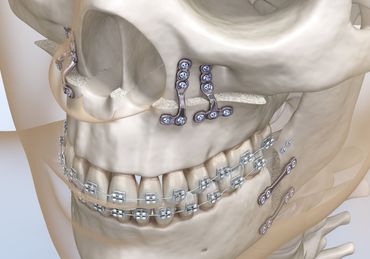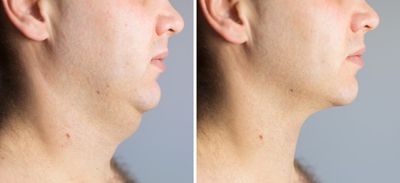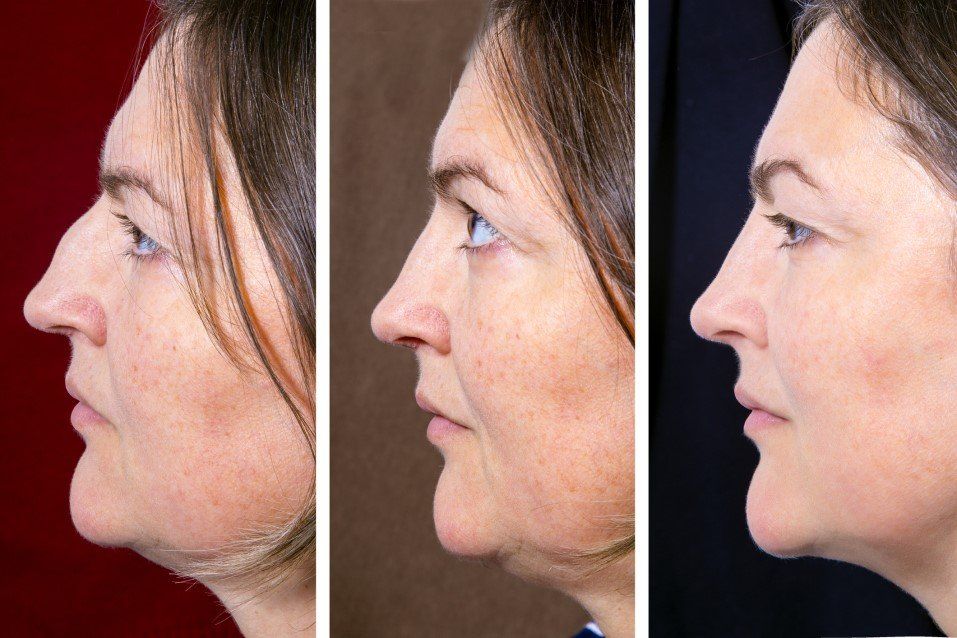Orthognathic Surgery
Orthognathic Surgery
What is Orthognathic Surgery?
Orthognathic surgery also called corrective jaw surgery is performed by a Specialist Oral and Maxillofacial Surgeon (OMS) to correct a wide range of minor and major skeletal and dental irregularities, including the misalignment of jaws and teeth.
An Orthodontist can correct a patient’s bite if only the teeth are misaligned, however where the jaw is misaligned corrective jaw surgery with an OMS, such as Dr John Webster, may be necessary.
Surgery of this type can improve chewing, speaking and breathing. While the patient's cosmetic appearance may be dramatically enhanced as a result of the surgery, orthognathic surgery is actually performed to correct functional problems.
What conditions can benefit from Corrective Jaw Surgery:
- Difficulty chewing or biting food
- Difficulty swallowing
- Chronic jaw or jaw joint (TMJ) pain and headaches
- Excessive wear of the teeth
- Open bite (space between the upper and lower teeth when the mouth is closed)
- Unbalanced facial appearance from the front or side
- Facial injury
- Birth defects
- Receding lower jaw and chin
- Protruding jaw
- Inability to make the lips meet without straining
- Chronic mouth breathing
- Sleep apnoea (breathing problems when sleeping, including snoring)
What does Orthognathic Surgery involve?
Orthognathic surgery involves combined treatment between your Dentist, Specialist Orthodontist and Specialist Oral and Maxillofacial Surgeon to determine whether you are a candidate for corrective jaw surgery. Once the treating team has agreed that orthognathic surgery is the best path forward for you a consultation with Dr John Webster will be coordinated with you. Dr Webster will determine which corrective jaw surgical procedures are required to provide you the safest and best cosmetic and functional outcome.
Dr John Webster has performed numerous orthognathic surgeries which can involve moving the maxilla (top jaw), mandible (bottom jaw) and chin into more aesthetically pleasing and better functional alignment of the jaws and teeth.
Before the surgery the Specialist Orthodontist will need to level and align the dentition in a way that facilitates/assists with aligning the jaws at the time of surgery. The surgery must be performed in hospital under a general anaesthetic and you will need to stay in hospital overnight for observation. Many patients do go home the next day after surgery to recover in their own home with regular review by Dr John Webster over the 6-week post surgical period that the jaw bones take to heal to 80% strength when a full chewing diet may resume.
If you think you are likely to require orthognathic surgery for functional reasons Dr John Webster suggests you consider obtaining private health insurance which will reduce your out of pocket expenses for the Specialist Orthodontist, Surgeon, Hospital and anaesthetist expenses. Please note that waiting period may apply.
How do I know if I need Corrective Jaw Surgery?
If you think you could benefit from corrective jaw surgery arrange a referral to Dr John Webster for a no obligation consultation to discuss your goals and potential treatment. Should orthognathic surgery be recommended Dr John Webster can provide options to you for a consultation with Specialist Orthodontist in the Toowoomba and Darling Downs region who shares a similar passion for corrective jaw surgery to assist in facilitating the process of treatment of the initial phases of his treatment plan. It is important that you and your family understand that the journey of corrective jaw surgery can take 12-24 months for all treatment to be completed so it is essential you are comfortable with the process. At your consultation Dr John Webster can show you many before and after examples of patients he has treated and explain the surgeries required to achieve those results.
Meet Brenna who had asymmetric growth of her jaws and corrective jaw surgery in her late teenage years. Brenna has authorised the American Association of Oral and Maxillofacial Surgeons to highlight what results can be achieved.
Can my nose and chin be treated at the same time?
Rhinoplasty (nose surgery) and Genioplasty (chin surgery) can be completed at the same time as your other corrective jaw surgeries and sometime genioplasty is already part of the treatment plan. If rhinoplasty is advised for cosmetic or breathing reasons some simple cases can be managed at the time of surgery however it is important to note that moving the jaws around can alter the position of the nose and therefore it is often advised to stage the surgeries and do the corrective jaw surgery first. After healing the position of the nose can be reassessed and provides opportunity to review the need the rhinoplasty surgery at all. In many cases if complex rhinoplasty is required Dr John Webster will refer you to an appropriate trained rhinoplasty surgeon who has done further post-fellowship training specific for your individual needs. If you elect to have everything done on the one day then it is just a matter of coordinating operating time and surgeon availability to meet your specific needs.
If you can’t tell if the issue is your nose or a jaw problem please arrange a referral from your GP to Dr John Webster and he will guide your through a thorough assessment and provide sensible advice on your treatment options including non-surgical and surgical options.
Are there any post-operative instructions?
At the initial consultation with Dr John Webster you will be provided with a set of post-operative instructions that are designed to optimize healing and minimise pain and complications during the recovery phase.
How can you book in for your Orthognathic Facial Corrective Surgery?
If you would like to know how we can help you further, or to book a no obligation initial consultation please phone 07 4580 4733
or alternatively request an appointment now online.






